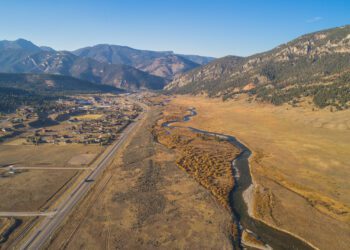By Marne Hayes EBS COLUMNIST
Nature tends to do a good job of keeping our ecosystems healthy. Animals, weather systems, aquatic habitats and wetland vegetation all have a role in what defines a river and the overall health of its surrounding watershed.
Beavers play a big role in this balance of keeping a river healthy.They are known as a “keystone species” due to their ability to shape freshwater ecosystems which provide vital habitat and resources to other animal and plant species. Odd as it may seem, beavers tend to be nature’s best engineers in terms of creating healthy, sustainable and functional streams and wetlands.
They are so important, in fact, that we—those of us in the business of restoring nature—often mimic the job of beavers, using their techniques to help keep water in our river systems longer, so that the ground, the river, and all of the wetland areas that contribute to the health of a river stay intact.
These nature-based techniques are called low-tech, process-based restoration. While the term may be a mouthful to say, in practice, it’s quite simple and highly effective. Fundamentally, LTPBR attempts to return a stream to its natural, undisturbed state by mimicking a healthy stream’s natural processes and functions. Streams and rivers throughout the Gallatin Watershed have been modified and degraded over the years. This alteration of natural processes has been detrimental to fish and wildlife and impacted the quantity and quality of our water resources.
That’s where beavers come into play. Their natural engineering creates the tendency for improved conditions for wetland vegetation just by doing what they do: creating obstacles, new ponds or sometimes better paths for streams, allowing more of the surface water to reach the aquifers below the surface. In the absence of the work of beavers, water that accumulates through runoff or rainfall quickly rushes down the stream channel and causes erosion as it goes.

In Big Sky, a good example of LTPBR that has seen great results is a restoration project by the Gallatin River Task Force along the Middle Fork of the West Fork Gallatin River. The GRTF mimicked the natural engineering of beavers, also known as beaver dam analog structures, to raise the water table in a wetland that was drying out. In addition to the beaver dam analogs, GRTF used small log jams, known as post assisted log structures, in the stream to create riffles and pools.
Through low-tech, process-based restoration techniques used at this site, the wetland was reconnected to the floodplain, suitable habitat was created for fish and other species, and natural conditions were given a kickstart. The efforts allow for the stream and wetland to be more conducive to holding water longer, capturing sediment and filtering pollutants, ultimately benefiting groundwater storage and water quality.
Low-tech process-based restoration offers promising and simple ways to start revitalizing the streams and wetland areas that feed the Gallatin River. Historically, beavers have been abundant throughout the West Fork waterways. But development and human interference have drastically reduced their population numbers; by restoring streams to their natural state as if beavers were present and allowing natural processes to take over, LTPBR promotes better health for the whole watershed. LTPBR approaches deliver desired ecological outcomes efficiently and at a low cost, especially compared to conventional approaches, but in a community like Big Sky that enjoys the benefit of public land and private land woven closely together, the support and trust of the community in implementing nature-based solutions is paramount to success and the long-term health of our water resources.
Past success with these types of restoration projects have resulted in improved streamflow patterns and improved wetland health. They have proven to reduce soil erosion, manage stormwater runoff, improve wildfire resiliency and sequester carbon.

One friend and partner to the task force, Connor Parish with Trout Unlimited, said it best:
“Nature is messy, and allowing streams to meander, beavers to work, and log jams to form on a large scale can help keep our water clean, provide more dependable late-season streamflow, and improve habitat for fish and wildlife.”
Mimicking what nature does fundamentally well is in our best interest. Using techniqes like LTPBR that are fashioned after the work of the notoriously busy beaver help our ground absorb more water by creating a slower flow during peak runoff and providing water to mainstem rivers—like the Gallatin—throughout the year.
We know that it will take a variety of improved practices to address more frequent drought and water quality issues that face a growing community like ours. But ours is not an isolated issue, and we can learn from other places across the West that have implemented similar LTPBR processes and seen great results for improving their water table, their habitat and wetland areas. Learn more about LTPBR projects happening in our watershed at gallatinrivertaskforce.org.
Marne Hayes is the communications manager for the Gallatin River Task Force.











